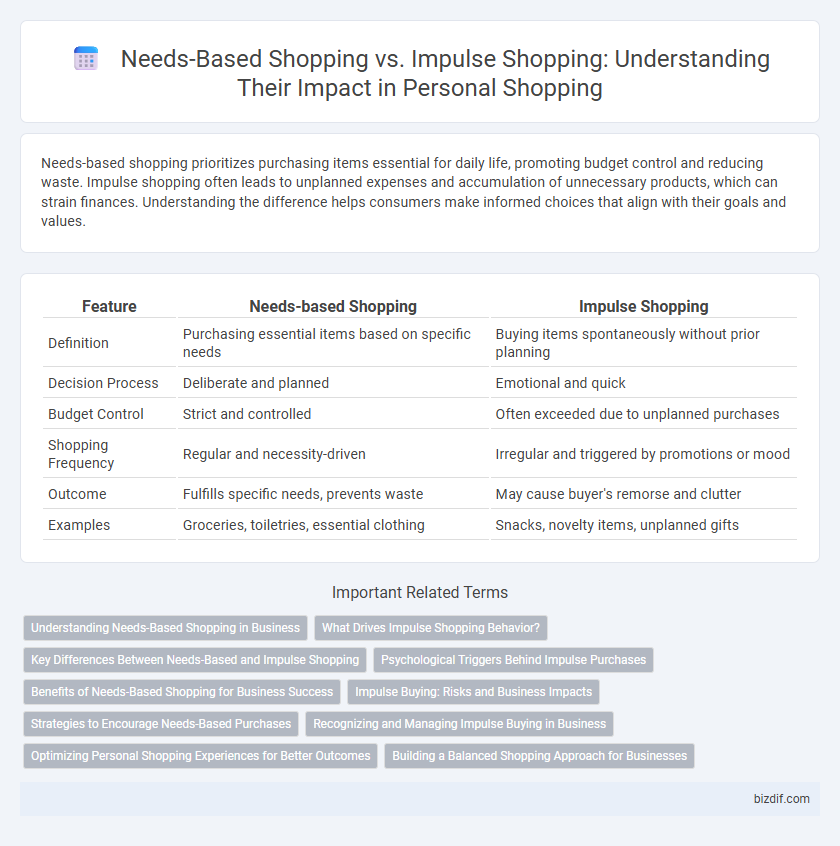Needs-based shopping prioritizes purchasing items essential for daily life, promoting budget control and reducing waste. Impulse shopping often leads to unplanned expenses and accumulation of unnecessary products, which can strain finances. Understanding the difference helps consumers make informed choices that align with their goals and values.
Table of Comparison
| Feature | Needs-based Shopping | Impulse Shopping |
|---|---|---|
| Definition | Purchasing essential items based on specific needs | Buying items spontaneously without prior planning |
| Decision Process | Deliberate and planned | Emotional and quick |
| Budget Control | Strict and controlled | Often exceeded due to unplanned purchases |
| Shopping Frequency | Regular and necessity-driven | Irregular and triggered by promotions or mood |
| Outcome | Fulfills specific needs, prevents waste | May cause buyer's remorse and clutter |
| Examples | Groceries, toiletries, essential clothing | Snacks, novelty items, unplanned gifts |
Understanding Needs-Based Shopping in Business
Needs-based shopping prioritizes customers' specific requirements and streamlines product selection to enhance satisfaction and loyalty. Businesses leveraging this approach analyze purchase patterns and customer data to tailor offerings, reducing inventory waste and increasing conversion rates. Understanding needs-based shopping enables companies to create targeted marketing strategies that meet real demands rather than reacting to spontaneous impulse buys.
What Drives Impulse Shopping Behavior?
Impulse shopping behavior is driven primarily by emotional triggers, such as excitement, stress relief, or the desire for instant gratification. Visual merchandising and strategic product placement tap into these emotions, encouraging unplanned purchases. Limited-time offers and appealing packaging also play significant roles in activating spontaneous buying decisions.
Key Differences Between Needs-Based and Impulse Shopping
Needs-based shopping centers on purchasing items essential for daily living, driven by pre-planned lists and specific requirements, ensuring budget control and utility. Impulse shopping occurs spontaneously, influenced by emotional triggers, promotional displays, or sudden desires, often leading to unplanned expenses. Key differences lie in motivation, decision-making process, and the level of planning involved, impacting overall spending behavior and financial management.
Psychological Triggers Behind Impulse Purchases
Impulse purchases are often driven by psychological triggers such as emotional gratification, scarcity perception, and instant reward mechanisms that bypass rational decision-making processes. In contrast, needs-based shopping prioritizes planned acquisitions aligned with specific goals, minimizing the influence of these emotional and cognitive biases. Understanding these triggers enables consumers to make more deliberate choices, reducing unnecessary spending and enhancing overall satisfaction.
Benefits of Needs-Based Shopping for Business Success
Needs-based shopping drives targeted purchasing decisions that enhance inventory management and reduce excess stock, improving cash flow and operational efficiency. Focusing on customer requirements allows businesses to tailor marketing strategies and product offerings, increasing customer satisfaction and fostering loyalty. Data-driven insights from needs-based shopping patterns support strategic planning, ultimately boosting profitability and long-term business growth.
Impulse Buying: Risks and Business Impacts
Impulse buying can lead to increased consumer debt and buyer's remorse, negatively affecting personal finances and emotional well-being. For businesses, reliance on impulse purchases may inflate short-term sales but risks long-term brand loyalty and customer satisfaction. Strategic management of impulse triggers is essential to balance revenue growth with sustainable customer relationships.
Strategies to Encourage Needs-Based Purchases
Implementing personalized recommendations based on customer purchase history enhances needs-based shopping by aligning products with actual requirements, increasing conversion rates by up to 30%. Retailers should use targeted promotions and loyalty programs to incentivize thoughtful purchases while reducing impulse buys that contribute to higher return rates. Clear product information and comparison tools empower consumers to make informed decisions, fostering long-term satisfaction and brand loyalty.
Recognizing and Managing Impulse Buying in Business
Impulse buying often leads to unplanned expenses that can disrupt business budgets and inventory management. Recognizing impulse buying behavior enables businesses to implement strategies such as limiting promotional triggers and encouraging needs-based decisions, fostering more sustainable purchasing patterns. Effective management of impulse buying helps maintain financial control and aligns purchases with strategic business goals.
Optimizing Personal Shopping Experiences for Better Outcomes
Needs-based shopping prioritizes identifying and fulfilling specific requirements, ensuring efficient and purposeful purchases that align with consumer goals. Impulse shopping, driven by spontaneous desires and emotional triggers, often leads to unplanned expenses and less satisfaction. Optimizing personal shopping experiences involves leveraging data analytics and personalized recommendations to balance needs-based strategies with controlled impulse opportunities, enhancing overall customer satisfaction and spending efficiency.
Building a Balanced Shopping Approach for Businesses
Businesses that implement a needs-based shopping strategy prioritize customer demands and essential product offerings, ensuring inventory aligns with genuine requirements. Incorporating insights from impulse shopping behaviors can drive spontaneous purchase opportunities through targeted marketing and strategic product placements. Balancing these approaches enhances customer satisfaction and optimizes sales by merging planned purchases with timely, appealing suggestions.
Needs-based shopping vs Impulse shopping Infographic

 bizdif.com
bizdif.com